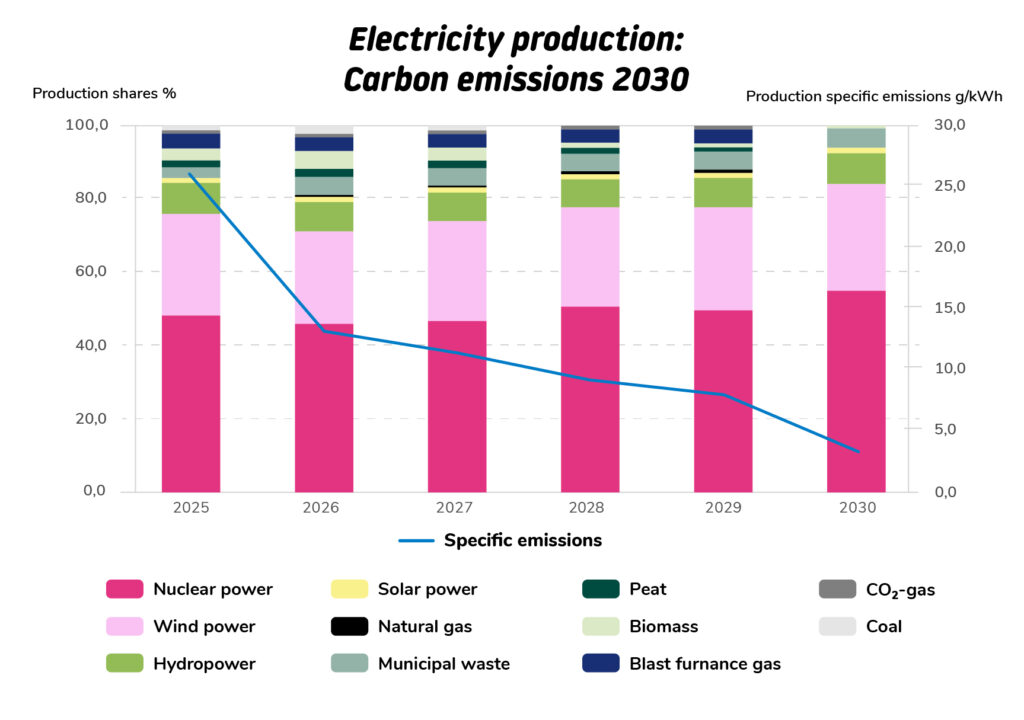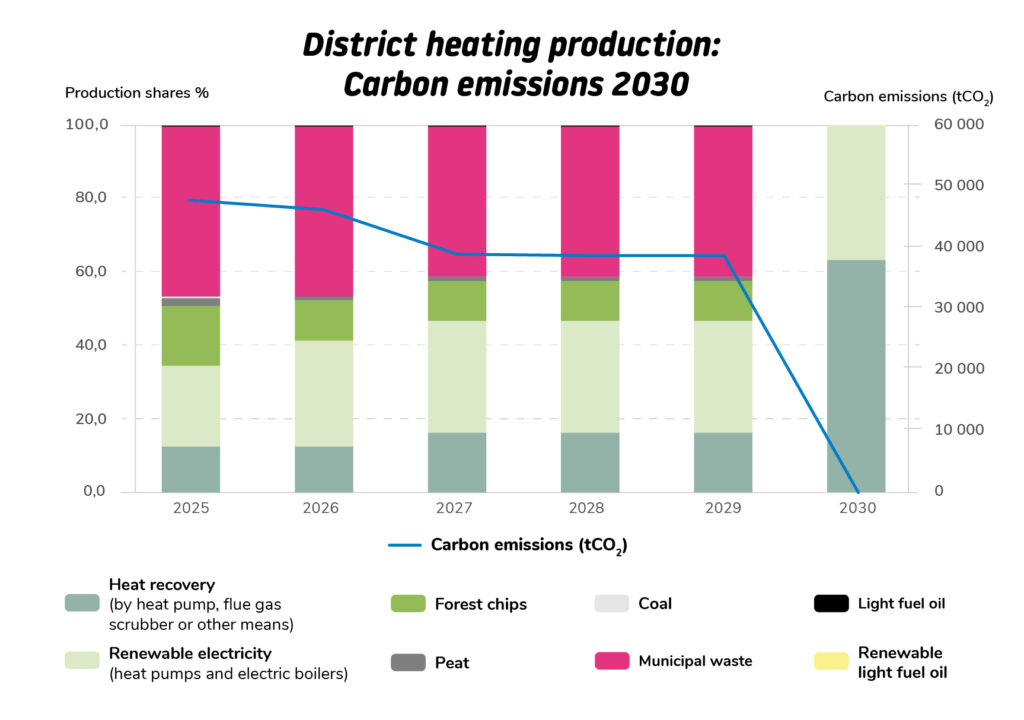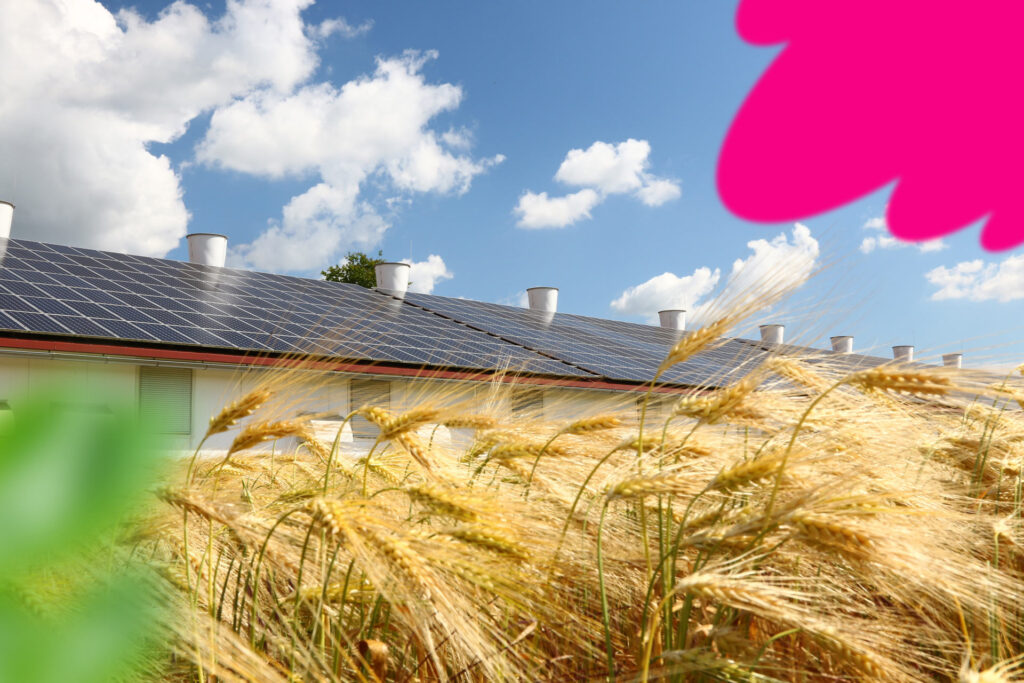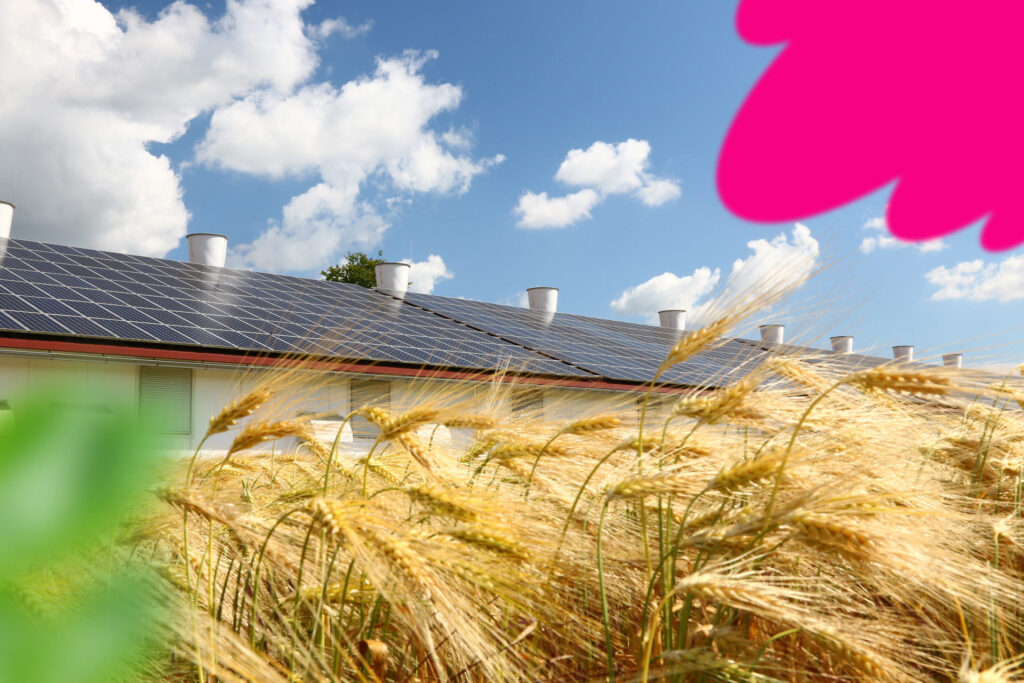
Sustainability work in the Vaasan Sähkö Group
The focus areas, goals, and vision of the Vaasan Sähkö Group’s sustainability strategy concerns the parent company Vaasan Sähkö and its subsidiaries Vaasan Sähkö Myynti and Vaasan Sähköverkko.
In 2024, we selected our environmental, social, and economic sustainability indicators for the group, defined their monitoring processes, and determined the necessary actions. Ernst & Young has been our partner in this work.
Strategic priorities
1.
Customer-centric green transition
- Development of new digital solutions for energy efficiency and a green society without compromising security of energy supply.
2.
Climate and nature protection in energy production and distribution
- Carbon-neutral basic production within this decade, in collaboration with key stakeholders and partners.
- Protection of biodiversity in energy production and distribution.
3.
Health, safety, and well-being
- A diverse, equal, inclusive, and thriving workplace.
- Zero workplace accidents (Lost-Time Injuries, LTI) in our own operations and subcontracting.
- Zero tolerance for violations of human rights and workers’ rights.
Objectives and monitoring, 2024
We promoted these matters in 2024 in our sustainability strategy work.
Customer-focused green transition
New smart electricity meters for Vaasan Sähköverkko’s customers, completed
More than 60,000 electricity meters were replaced by October 2024.
New products and services
- The Influencer product launched
- Energy audit service for district heating customers introduced
- Development of the Vaasan Sähkö mobile app and online service
- The renewed online service was introduced on 1.4.2025.
Climate and nature protection in energy production and distribution
Carbon neutrality roadmap, completed
Roadmaps for district heating and electricity production have been cpmpleted during the first half-year of 2025. See the roadmaps in Finnish or Swedish. The roadmaps are updated on a yearly basis or as required.
Taxonomic review, completed
Taxonomy-compliant, taxonomy-eligible, and non-eligible activities have been identified.
Report on the impacts of our operations on biodiversity, completed
Effects assessed according to the LEAP method. Proposals for environmental restoration measures have been made.
Report on the impacts of our operations on biodiversity, completed
Effects assessed according to the LEAP method. Proposals for environmental restoration measures have been made.
Emission calculation according to the greenhouse gas emission reporting standard, GHG Protocol (scope 1, 2, and 3), completed
Emissions calculation made for 2023. Comparable figures for future reporting have been obtained.
Double materiality analysis, completed
In the early stages of the strategy work, the themes and indicators relevant to the Group’s business operations were defined.
Health, safety, and well-being
Plan for diversity work 2024–2025, completed
Implemented in cooperation with the personnel. Check out the plan here (in Finnish).
Occupational safety training, completed
Supply chain management, in progress
- General ESG criteria defined for the supplier selection process
- Supplier code of conduct is still being processed. Internal training to be organized before implementation.
Zero occupational accidents
- Occupational accidents leading to absences (LTI): 1 in 2024.
Road maps for carbon neutrality 2025-2030



Employee involvement
The entire staff of our group has participated in the sustainability strategy work through surveys, multiple workshops, and information sessions.
At the start of the strategy process, employees were asked about their expectations for the group’s sustainability efforts. The majority expressed a desire for social, economic, and/or environmental sustainability to serve as drivers in all activities of the Vaasan Sähkö Group.

Stakeholder perspectives
At the beginning of the strategy process, we interviewed representatives of various stakeholders to gain a deeper understanding of their expectations for our work.
We were particularly called upon to take action to protect biodiversity in energy production and distribution, ensure responsible supply chain management, and promote diversity within the workplace.
Olli Arola, Director of Strategy and Corporate Responsibility
Reporting schedule
The EU’s new Corporate Sustainability Reporting Directive (CSRD) will most likely apply to Vaasan Sähkö Group starting from the 2027 reporting year. This means that we will provide detailed reports on the sustainability of our business operations as part of the annual report published in 2028.
Originally, the sustainability reporting obligation was supposed to apply to us already from the reporting year 2025, but the European Commission has made a proposal to simplify the sustainability reporting obligations. We will continue our work to achieve reporting readiness, and time will tell what the final reporting obligations will be for companies of our size.
Specific features of the energy sector operating environment
Green transition
The energy sector is currently most influenced by the general efforts to reduce emissions. These efforts are reflected in national economic policies, industry emission targets, and consumer choices. The green transition has introduced new, clean forms of energy production. According to Finnish Energy, in 2023, the share of emission-free electricity production in Finland was 94% of the total production.
However, the energy sector remains the largest source of greenhouse gas emissions in Finland (source: Statistics Finland).
The Finnish government has aimed to promote the transition through various forms of support, including investment in clean energy production. Energy sector regulations are made both at national and European Union levels. For example, legislation will end the use of coal in energy production by 2029.
Emission reduction targets for different sectors
Different sectors have their own emission reduction targets, including large industrial sectors that use significant amounts of electricity in their production processes. Global emission reduction targets also affect these sectors that strive to transition to renewable or emission-free electricity.
Finance
Emission reduction targets and other sustainability considerations also impact various financial instruments, such as available public subsidies and companies’ ability to obtain loans.
Additionally, the EU taxonomy influences this area by defining sustainable economic activities.
Consumers’ own electricity production
In recent years, consumers have increasingly become electricity producers, with the number of solar panels increasing. In Finland, the installation of consumers’ solar panels was accelerated in 2022 due to the energy crisis and the rising price of electricity. According to the Energy Authority, solar power production in Finland grew by over 60% in 2022 compared to 2021. Small-scale production has also increased since then. According to the statistics of the Energy Authority, the output of small-scale solar energy production in 2023 was over 900 megawatts, while in the previous year it was slightly more than 600 megawatts.
Electrification of society
A major global trend influencing the energy sector is the electrification of society, with electric transportation forming an important part of it. An increasing portion of society requires electricity to function. Examples include transportation, data centers, and crypto mining, all of which contribute to increased electricity consumption.
Despite this, Finland’s electricity consumption decreased by approximately 2% in 2023 compared to the previous year, according to the Finnish Energy.
The electrification of society is the key to reducing emissions, but at the same time it sets new requirements for a stronger and more flexible electricity grid. Electricity distribution companies play an important role in this process, enabling the transmission of electricity from producers to consumers and maintaining the balance and reliability of the energy system.
Energy self-sufficiency and security of supply
Geopolitical situations have had a significant impact on Finland’s energy policy. Russia’s invasion of Ukraine in February 2022 led to commercial sanctions, and electricity imports from Russia, which had previously made up a significant portion of Finland’s electricity supply, were halted. The flow of other energy forms also ceased due to sanctions.
Cybersecurity threats and the side effects of the geopolitical situation have highlighted the importance of energy self-sufficiency and security of supply (source: Fingrid).
Green claims
Sustainable communication is increasingly gaining ground in any industry. Consumer confidence in companies’ sustainability claims is weak, which is one of the reasons why it is particularly important to strive for sustainability also in communications. In the energy sector, where emissions from production pose a major challenge, it is essential to pay attention to so called green claims. At Vaasan Sähkö Group, we have therefore started to train content producers and build a greater understanding of the importance of the issue. We are working hard to ensure that our communications are accurate and that we provide facts to support our claims. We also welcome feedback on our communications.
Impact of the specific features on energy sector operators
The phenomena mentioned above are all essential in the energy sector. Emission reduction targets and financial instruments are steering the energy sector towards emissions-free production, which requires significant investments. The size of energy sector investments is such that the return on investment often takes decades to materialize.
New energy production and storage solutions are often aimed at increasing the flexibility of the energy system and smoothing out production and consumption peaks. Additionally, these solutions aim for greater cost efficiency and reduced emissions.

The green transition and the increasing share of renewable energy with variable production levels affect the entire electricity market, introducing fluctuations.
The electricity market price is based on supply and demand, and the greater the variation in these, the larger the fluctuations in market prices.
There is a need for solutions that enable so-called demand response, i.e., adjusting electricity consumption. Solutions that integrate electricity and heat production, balance consumption peaks, and thereby stabilize prices also contribute to market stability.
The growing electricity demand of society, new renewable energy production methods, and consumer-generated electricity impose new requirements on the development of the electricity grid.
Maintaining a high level of reliability in electricity transmission is essential for societal development.
There are also statutory requirements for delivery reliability for distribution companies. For this reason, investments are needed to strengthen and further develop the electricity grid.

The foundation of a sustainable business
As part of our sustainability work, we have identified the factors that form the foundation of sustainable business practices:

Transparency, good governance, and profitability
- Reporting and transparency
- Active communication
- Stakeholders and supply chain management
- Good governance and compliance with regulations
- Sustainability in daily operations
- Leadership
- Profitability and competitive pricing
Contact person
Olli Arola, Director of Strategy and Corporate Responsibility
olli.arola@vaasansahko.fi